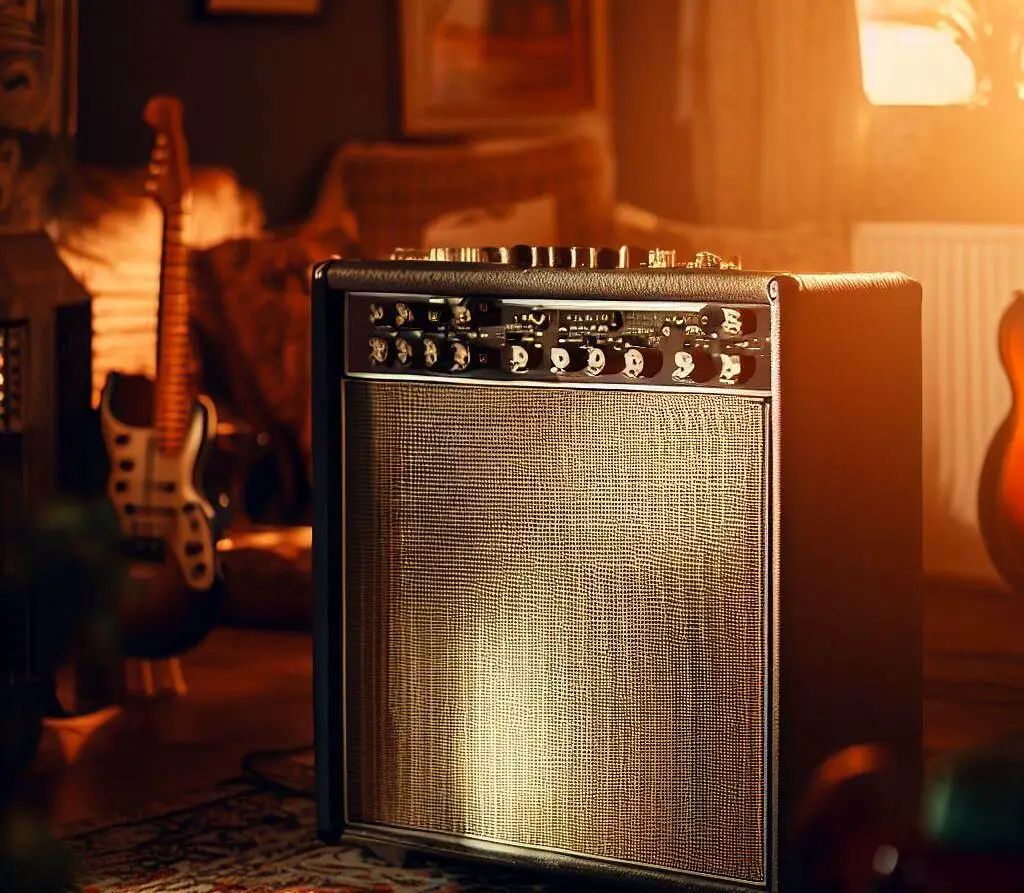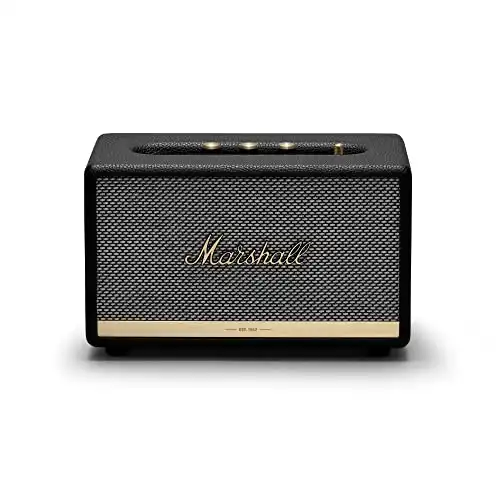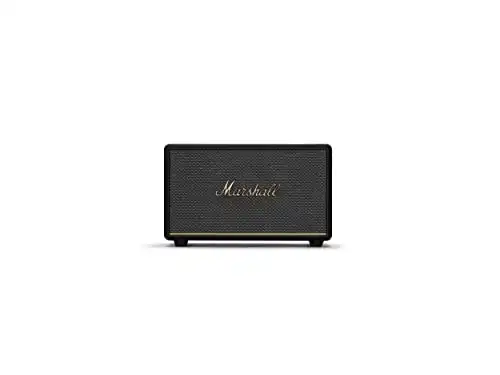If you are looking to combine style and sound quality, few brands can compete with Marshall. The iconic brand that we typically associate with guitar amps also manufactures some of the top bluetooth speakers on the market today.
Here, we look at the smallest (and least expensive) product in Marshall’s Home Line — the
One defining feature of the Marshall Home Line is the lack of a built-in battery (hence the name “home,” rather than “portable”). So if you are looking for a portable speaker that can be used unplugged, you should consider alternatives instead.
On the other hand, if you want a higher-end Marshall (and are willing to pay the price), consider the Stanmore or Woburn series. Stanmore [see review] and Woburn [see review] both have similar features to the Acton, but are larger speakers that provide more power and volume.
For a discussion of the
|
|
|
~~~ Check Price: Marshall Acton 2 ~~~
~~~ Check Price: Marshall Acton 3 ~~~
Summary
Acton 2 and Acton 3 are similar speakers. The appearance and size are almost identical, and the power output and speaker composition are the same also.
However, Acton 3 provides several clear upgrades over Acton 2:
- Improved soundstage resulting from tweeters with a wider outward-facing angle.
- Enhanced sound quality even without considering the soundstage or width of sound.
- Upgraded Bluetooth connectivity (Bluetooth 5.2 vs. 5.0).
- An added track forward/backward button.
- Several software upgrades.
If you are looking to a purchase a new speaker, the Acton 3 provides a much better listening experience. Unless you can find the Acton 2 available at a massive discount, I wouldn’t try to save the money by buying the older version.
For the budget-conscious shoppers looking to shop sales on an older model, consider the Marshall Stanmore 2 if it gets deeply discounted. If you can find the Stanmore 2 for a similar price as the Acton 3, you are getting a larger and more powerful speaker that still has the beautiful Marshall design and signature sound.
In the sub-$300 price range,
Sound
Generally, an updated version in a speaker series is just a refresh with a few changes. In reviewing the Marshall Stanmore 2 vs. Stanmore 3, that is exactly what we found.
But when it comes to the Acton series, the Acton 3 seems to be totally reinvented. This is a positive outcome, since smarter tech reviewers than myself tended to agree that the Acton 2 was an auditory disappointment.
Both speakers have a 30 watt sub and two 15 watt tweeters, so nothing is different in that regard. On the new version, the tweeters are oriented at more of an angle, which attempts to improve the soundstage. While that sounds like an overly simple gimmick, the soundstage does seem to be improved on the new version.
Acton 3 also adds a “Dynamic Loudness” feature that modifies the equalizer based on your listening volume. This feature wasn’t noticeable during testing, but your experience may vary.
Like the rest of the Home Line series, the Acton 2 and Acton 3 both have bass and treble controls right on the device, which is a wonderful feature.
Although the Acton 2 is actually rated with a higher maximum volume, there wasn’t much difference in testing. Plus, the Acton 2 tends to distort more when playing at louder volumes. So, I would rate the Acton 3 as a better listen at high volumes, despite having a max that is technically lower.
The sound profile is excellent right out of the box, so the EQ is appreciated but not really necessary. Compared to the Stanmore and Woburn, which are much more expensive, you could easily argue that Acton 3 is the best value of the Home Line III series.
Sound winner: Acton 3 (better, cleaner sound, along with a wider soundstage)
Design
The beautiful design is where Marshall speakers differentiate themselves. Both speakers feature Marshall’s classic guitar amp design, which provides a classy, retro style. Each model is well-built and sturdy.
The major differences, in terms of design, are that the Acton 3 adds a switch for skipping tracks (Acton 2 only had play/pause) and also features a more “eco-friendly” design. Marshall advertises that the speaker uses 70% recycled plastic, is totally PVC free, and is vegan friendly (meaning the “leather” exterior isn’t real).
The Acton 3 is slightly larger, but not enough to notice a difference. The brass-colored plate towards the bottom of the speaker is smaller on the Acton 3. This isn’t really an upgrade or downgrade, but rather is just a matter of personal preference.
Neither has a port for RCA cables or HDMI (like the larger Home Series speakers do). But both the Acton 2 and 3 feature the 3.5 mm aux input, thankfully. Marshall doesn’t include the cable itself, but most of us have one laying around somewhere, anyway.
Between the aux input and bluetooth, you still won’t have any issues connecting either speaker to your audio source.
Both versions have 3 color choices, including black and brown. However, the white option on Acton 2 has been replaced by a cream option on Acton 3. I really like the esthetics of the white Acton 2, but the cream color better matches the retro vibe that Marshall is going for.
Overall, both speakers score high marks for design and build quality. The vintage styling really differentiates Marshall speakers from the thousands of bluetooth speakers with cheap, all-plastic builds. If you are okay with forgoing a built-in battery, the Acton series is a 10/10 for design.
Design winner: Acton 3 (added track skip controls, plus uses recycled materials)
Durability
Because the Acton 3 is new to the market, the durability discussion will be challenging.
However, the build quality of Acton 2 & 3 is similar in almost every way — so unless the new model has an unexpected electrical or software defect, the durability of each speaker should be roughly equal.
Here are the things we can say with certainty:
- After 4 years on the market, the Acton 2 scores pretty well for durability and longevity.
- Marshall is one of the more reliable speaker companies
- The speakers’ lack of a built-in battery ensures that battery degradation will never cause device failure.
Build quality is solid, and the faux leather is pretty resistant to scratches and dings.
Although the exposed knobs and speaker cover are vulnerable points, this isn’t going to be as much of an issue for a bookshelf speaker as it would be for a true portable speaker. If this was an on-the-go device that you clipped to a backpack or brought with you on trail rides, there would be definite durability concerns.
Durability winner: Tie
Battery
It is important to note that neither the Acton 2 or 3 has a built-in battery.
Usually, we equate “bluetooth speaker” with “portable speaker.” With the Marshall Home Line series, these are more like bookshelf speakers that also feature bluetooth connections.
The disadvantage, of course, is that the speaker can’t be used on-the-go, since it requires a power source. However, it is still relatively portable compared to many speakers.
It has a power cord, weighs only a couple pounds, and can be connected via bluetooth or an aux cable. So it isn’t like you will have to bring speaker wire and an amplifier if you wanna use it listen to tunes at a friend’s house.
As we wrote when discussing the Marshall Woburn and Marshall Stanmore, there are still some advantages to the absence of a built-in battery. Because built-in batteries eventually fail (even in the highest dollar speakers on the market), the lack of a battery should extend the lifespan of the
For Marshall speakers that are truly portable, with a built-in battery, consider the Emberton among budget options or the Tufton among more premium choices.
Software
Software differences exist between the two devices. However, most of them are window dressing rather than significant changes.
To begin, Acton 3 comes with Bluetooth 5.2, rather than the Bluetooth 5.0 seen on the Acton 2. This allows for over-the-air updates, and promises future features like Multistream and Broadcasts. Generally, it is best to avoid getting too excited about features that are “coming soon” — unless you are prepared to wait months or years.
A large advantage of Bluetooth 5.2 — the low energy consumption — is lost on the Acton 3 since battery life isn’t a factor. Sure, the more efficient Bluetooth 5.2 will still use less power than Acton 2. But I wouldn’t expect to notice any savings on your electric bill!
Each speaker features a fairly simple app that is highlighted by an adjustable equalizer. The Acton 3 also introduces the “Placement Compensation” feature to adjust sound settings based on obstructions in the room environment, but this feature really doesn’t move the needle too much.
Although the concept is clever, I would rather position my speaker correctly than be able to point it at a wall and then use an app to tell the speaker to adjust its sound profile because it is pointed towards a wall.
Neither speaker provides WiFi or a built-in microphone.
Ultimately, the key difference is just Bluetooth 5.0 versus 5.2. Since Bluetooth 5.2 should have the ability to improve communication between devices, function should be smoother and with less latency.
Software winner: Acton 3 (newer bluetooth version & the promise of future updates and enhancements)
Final Thoughts
The Acton 3 is a sizable improvement over the previous generation Acton 2.
While Marshall advertises features like over-the-air updates, wider soundstage, and recycled materials, it is the difference in sound quality that justifies the upgrade.
If you are looking for a quality bluetooth speaker under $300 that provides room-enhancing esthetics, the
If you can find the Acton 2 available at a massive discount, it could also be worth considering if you highly value the Marshall look. But honestly, it would be better to spend the extra money for Acton 3, or else just consider other bluetooth speakers.
|
|
|
~~~ Check Price: Marshall Acton 2 ~~~
~~~ Check Price: Marshall Acton 3 ~~~
FAQs
What are the key differences between the Marshall Acton 2 and Acton 3?
The key differences between the
Does the Marshall Acton 2 or Acton 3 have a built-in battery?
Answer: Neither the
Is the sound quality of the Marshall Acton 3 better than the Acton 2?
Answer: Yes, the Acton 3 provides a clear upgrade in terms of sound quality. Although both speakers have a 30-watt sub and two 15-watt tweeters, the Acton 3 offers improved soundstage and overall sound quality. The Acton 3 also adds a “Dynamic Loudness” feature that modifies the equalizer based on your listening volume.




